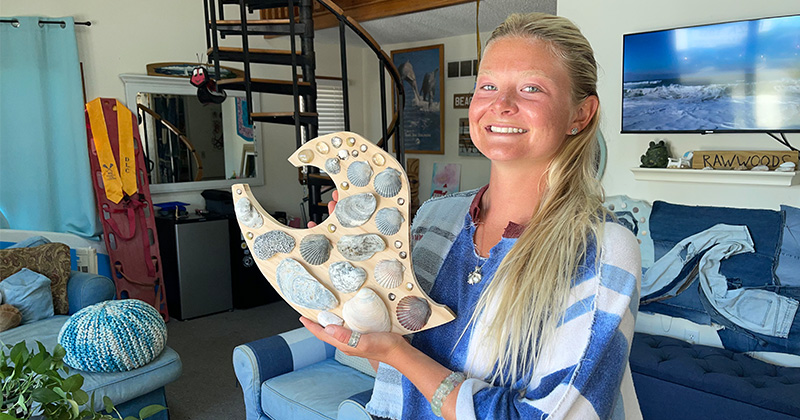


Coastal culture
Timelapse video and photo by Sam Kmiec August 21, 2025
UD senior uses art to explore the rhythms of the ocean
Editor’s note: Every year, hundreds of undergraduates at the University of Delaware pursue research under the guidance of a faculty mentor, especially during the summer months. Such experiences provided by UD — a nationally recognized research university — can be life-changing, introducing young scholars to a new field, perhaps even the path to a future career, as they uncover new knowledge. These spotlights offer a glimpse into their world.
University of Delaware senior Meredith Lockwood first learned the art of collecting and arranging shells from her mother. As a child, her mom would take Lockwood and her sisters to the beach to make seashell wreaths. This early experience is a cherished memory for Lockwood, bringing back the warmth of her childhood growing up in Rehoboth Beach, Delaware.
This summer, the UD art major is creating a series of shell mosaic panels that reflect coastal culture and sustainability as part of her undergraduate summer research project. Using locally sourced shells and eco-friendly materials, she is exploring how art can embody the rhythms of the ocean and the communities shaped by it, under the guidance of Aaron Terry, assistant professor of art and design. Her process unfolds along the Delaware coast and in her home studio — spaces she says are “filled with light, sand and the scent of salt air.”
Q: Why did you want to pursue this — what intrigues you about the topic?
Lockwood: When I was younger, my mom would take my sisters and me down to the beach to make seashell wreaths. We’d dig circles in the sand, carefully arrange shells and pour plaster of Paris to set them in place. One of those wreaths still lives on my windowsill today — a small but powerful reminder of those childhood memories and of how deeply the beach shaped me.
Growing up with the ocean as my safe space, it became more than just a place — it was a teacher, a muse and a sanctuary. This project feels like a continuation of that relationship. By working with natural materials, I’m not only creating art but also sharing a message about our connection to the environment and the importance of honoring it.
Q: Why does research like this matter?
Lockwood: Working with natural materials has taught me the value of slowing down, creating with intention and establishing rhythms that feel like rituals — collecting, sorting, arranging and refining. These habits aren’t just foundational for the work itself; they’re practices for a more grounded, sustainable way of living and creating. It’s a reminder that even small, consistent actions — like the placement of a single shell — can ripple outward in meaningful ways.
UD Shell Timelapse: https://capture.udel.edu/media/1_7ux76fip/
Q: What does your daily research/work entail?
Lockwood: By day, I work on the beach as a lifeguard in Rehoboth Beach, Delaware, surrounded by the ocean’s rhythms. When I’m not on the stand, I’m barefoot in the sand, combing the tide line for shells weathered by water and time. Back in my studio, I clean, sort and arrange the shells into intricate patterns on pieces of driftwood and wood panels I cut into organic shapes — some shaped like waves and one larger piece shaped like a surfboard. I’m experimenting with plaster and eco-friendly adhesives that are as gentle on the environment as they are durable. The process is slow and meditative; each shell placed with intention — echoing the patience and presence the ocean has taught me. When I finish, I’d love to display them somewhere in the Rehoboth Beach community or within the local art scene. It feels special to think about the work being shown in the place that inspired it.
Q: What’s the coolest thing about being involved in this project?
Lockwood: The coolest part of this project has been getting to blend so many of my passions — my love for the ocean, sustainability and creating art that feels deeply connected to place. Some of the most inspiring moments come while searching for materials, like discovering pieces of driftwood shaped by the tide or shells weathered by time. Those small finds feel like gifts from the shore and bring a sense of story and history into the work.
Q: Is there anything you’ve discovered about yourself and your career goals?
Lockwood: This work has shown me the kind of artist and designer I want to be — someone whose work carries meaning beyond aesthetics. I’m inspired to pursue a path where creativity and environmental consciousness intersect — whether in interiors, public art or community-based projects.
UD has really helped me grow into the artist I am today. Taking classes like ceramics and photography gave me space to experiment and figure out what I love, and art history helped me see how much art is shaped by place and culture. Working with Professor Aaron Terry on this project has been huge — he’s encouraged me to think about how my work can tell a story and make an impact. I’m so thankful for the freedom and support I’ve had here to explore my passions and start building a creative path that feels true to me.
Q: What do you enjoy doing in your spare time?
Lockwood: I’m happiest near the water — swimming, practicing yoga or simply walking the beach and spending time with my friends and family. I also love curating spaces that feel calm, grounded and infused with natural elements.
Contact Us
Have a UDaily story idea?
Contact us at ocm@udel.edu
Members of the press
Contact us at mediarelations@udel.edu or visit the Media Relations website

